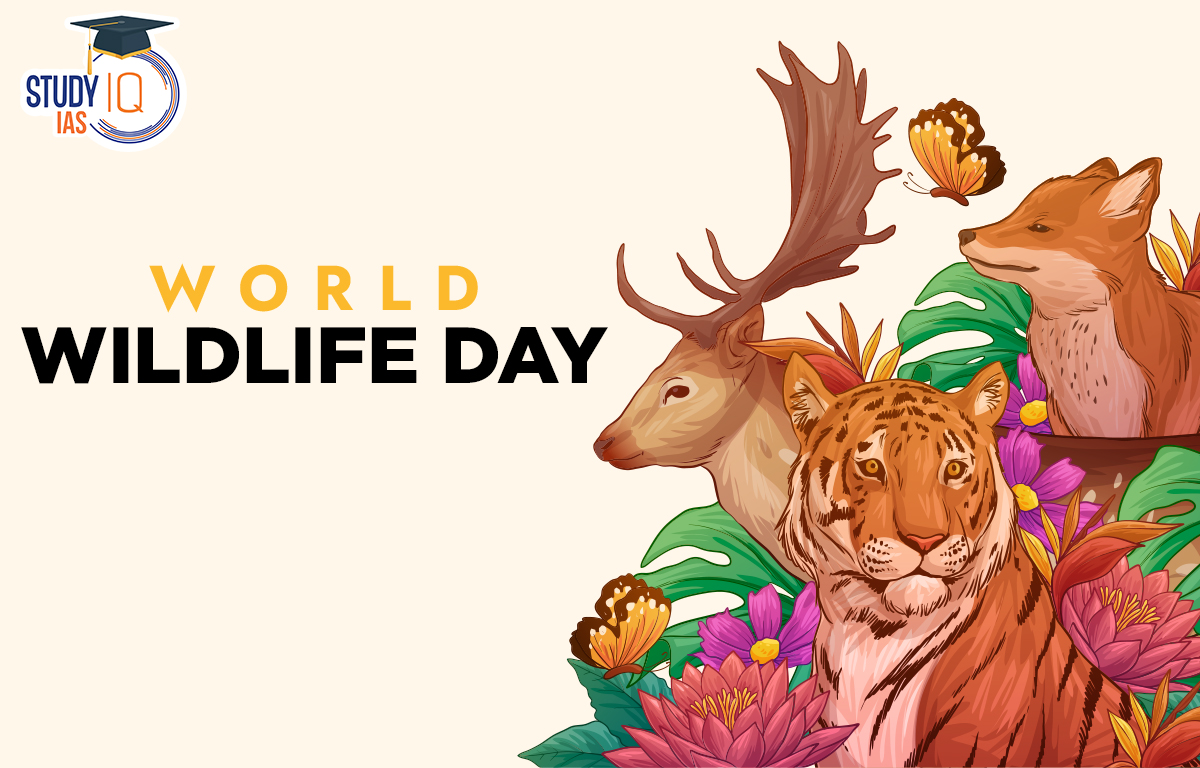Table of Contents
World Wildlife Day is observed annually on March 3 to raise awareness about wildlife conservation and biodiversity. This global event, established by the United Nations, highlights the need to protect endangered species and promote sustainable ecosystems. In 2025, the theme for World Wildlife Day is “Connecting People and Planet: Exploring Digital Innovation in Wildlife Conservation.”
Marking the occasion, Prime Minister Narendra Modi visited the Gir Wildlife Sanctuary in Gujarat, emphasizing India’s commitment to wildlife conservation and habitat protection.
World Wildlife Day 2025
World Wildlife Day 2025 serves as a reminder of our collective responsibility to protect the planet’s incredible biodiversity. Whether through education, conservation projects, policy-making, or grassroots activism, every effort counts in ensuring a sustainable future for wildlife and ecosystems.
| Details | |
|---|---|
| Event Name | World Wildlife Day 2025 |
| Date | March 3, 2025 |
| Theme | “Connecting People and Planet: Exploring Digital Innovation in Wildlife Conservation.” |
| Established by | United Nations General Assembly (UNGA) |
| First Observed | March 3, 2014 |
| Significance | Celebrates and raises awareness about wildlife conservation and biodiversity |
| History | Commemorates the signing of CITES (Convention on International Trade in Endangered Species) on March 3, 1973 |
| Celebrations | Awareness campaigns, wildlife conservation programs, seminars, exhibitions, and social media initiatives |
| Global Involvement | Governments, NGOs, conservationists, educational institutions, and the general public participate worldwide |
Theme of World Wildlife Day 2025
In 2025, the theme for World Wildlife Day is “Connecting People and Planet: Exploring Digital Innovation in Wildlife Conservation.”
The 2025 theme focuses on the role of digital technology in conservation efforts. As human activities continue to impact natural habitats, advanced technology, including AI-driven monitoring systems, GPS tracking for endangered species, and data analytics for conservation planning, is playing a vital role in wildlife protection.
Previous themes have included:
- 2024: “Connecting People and Planet: Exploring Digital Innovation in Wildlife Conservation”
- 2023: “Partnerships for Wildlife Conservation”
- 2022: “Recovering Key Species for Ecosystem Restoration”
PM Modi’s Visit to Gir Wildlife Sanctuary on World Wildlife Day 2025
On this special day, PM Narendra Modi visited the Gir Wildlife Sanctuary, the only home to Asiatic lions, to highlight India’s conservation efforts. Spending the night at Sinh Sadan, a forest guest house in Sasan Gir, PM Modi embarked on a lion safari on Monday morning. Accompanied by senior ministers, forest officials, and conservationists, his visit underscored the government’s proactive approach to biodiversity protection.
Following the safari, PM Modi chaired the seventh meeting of the National Board for Wildlife (NBWL) at Sasan Gir. This 47-member board, which focuses on wildlife conservation policies, includes representatives from various states, NGOs, and the Chief of Army Staff.
World Wildlife Day History
World Wildlife Day traces its origins back to 2013, when the United Nations General Assembly (UNGA) proclaimed March 3rd as an international day to recognize and celebrate the importance of wildlife. This date was chosen to commemorate the signing of the Convention on International Trade in Endangered Species of Wild Fauna and Flora (CITES) on March 3, 1973.
Key milestones in World Wildlife Day history:
-
- 1973: CITES was signed to regulate the trade of endangered species.
- 2013: The UNGA officially declared March 3rd as World Wildlife Day.
- 2020s: Increased focus on digital innovation and climate change in wildlife conservation efforts.
World Wildlife Day Aim
- World Wildlife Day aims to promote the significance of safeguarding wildlife and their habitats.
- It strives to raise awareness about the various threats confronting wildlife, including habitat loss, poaching, and climate change.
- Organizations and individuals globally organize diverse events and activities annually to celebrate World Wildlife Day.
- These activities encompass educational programs, awareness campaigns, community events, art and photography exhibitions, and wildlife safaris, among others.
How is World Wildlife Day Celebrated?
World Wildlife Day is celebrated globally through various activities, events, and initiatives aimed at raising awareness and encouraging action. Some of the most common ways to mark the occasion include:
1. Awareness Campaigns & Educational Programs
- Schools and universities conduct seminars, workshops, and panel discussions on wildlife conservation.
- Social media campaigns featuring infographics, videos, and hashtags help spread awareness.
2. Conservation Efforts & Wildlife Protection Initiatives
- Organizations launch reforestation projects, wildlife rescue operations, and habitat restoration programs.
- Governments implement stricter anti-poaching laws and wildlife trade regulations.
3. Film Screenings & Documentaries
- Environmental groups release documentaries and short films highlighting challenges faced by endangered species.
- Special screenings in educational institutions and public forums foster discussion and engagement.
4. Community Engagement & Ecotourism
- Wildlife sanctuaries and national parks organize guided eco-tours and conservation workshops.
- Local communities participate in art exhibitions, storytelling sessions, and wildlife photography contests.
5. International Conferences & Policy Dialogues
- UN agencies, conservationists, and policymakers discuss strategies to combat wildlife trafficking and habitat destruction.
- Governments and NGOs collaborate on global conservation agreements and funding initiatives.
Significance of World Wildlife Day 2025
World Wildlife Day serves as a critical platform to address pressing environmental issues and promote sustainable solutions. Here’s why it matters:
1. Protection of Endangered Species
Many species are on the verge of extinction due to deforestation, climate change, and illegal wildlife trade. World Wildlife Day highlights the urgency of protecting vulnerable species and restoring their habitats.
2. Promotion of Biodiversity Conservation
Biodiversity is vital for maintaining ecological balance. This day underscores the importance of conserving forests, wetlands, oceans, and grasslands to sustain wildlife populations.
3. Addressing Climate Change Impacts
Rising temperatures, pollution, and habitat destruction have devastating effects on wildlife. World Wildlife Day advocates for climate action and sustainable practices to protect natural ecosystems.
4. Encouraging Global Cooperation
Wildlife conservation requires international collaboration. Governments, conservation groups, and individuals work together to develop and implement effective wildlife protection policies.
5. Aligning with the United Nations Sustainable Development Goals (SDGs)
World Wildlife Day aligns with several UN SDGs, particularly:
- SDG 13: Climate Action
- SDG 14: Life Below Water
- SDG 15: Life on Land
By focusing on sustainable development, the event promotes a holistic approach to wildlife conservation.


 Indian Councils Act 1861, History, Provi...
Indian Councils Act 1861, History, Provi...
 Daily Quiz 17 April 2025
Daily Quiz 17 April 2025
 Nilgiri Biosphere Reserve, Map, Climate,...
Nilgiri Biosphere Reserve, Map, Climate,...





















